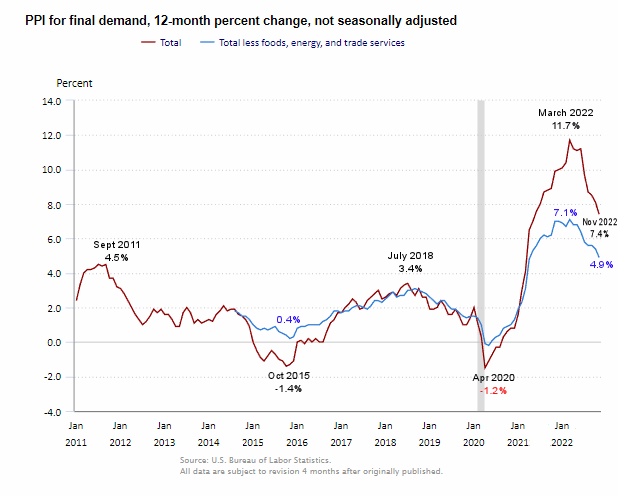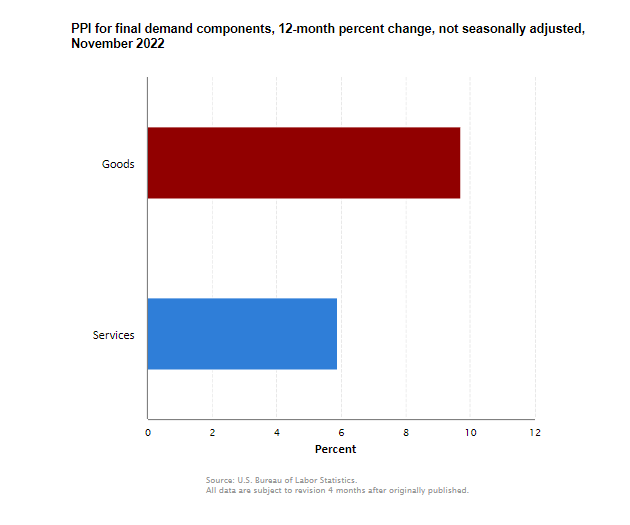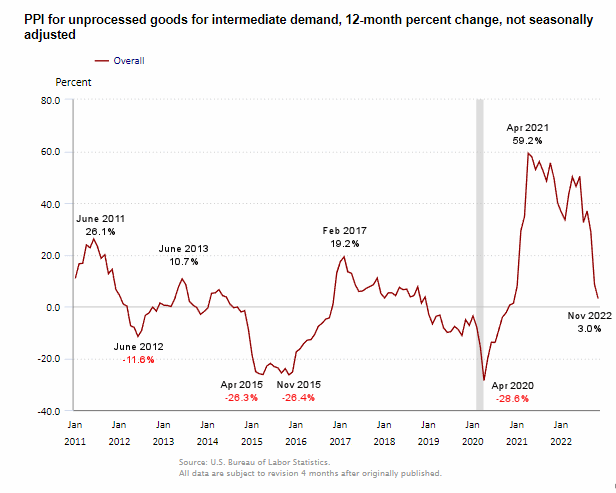Typically when we think of inflation, we look at the Consumer Price Index (CPI), which measures prices affecting Consumers. Today we are going to look at the November Producer Price index. According to the U.S. Bureau of Labor Statistics (BLS), “the Producer Price Index (PPI) measures the average change over time in the prices domestic producers receive for their output. It is a measure of inflation at the wholesale level that is compiled from thousands of indexes measuring producer prices by industry and product category.” The index is published monthly, but unlike the CPI, the PPI is subject to adjusting/correcting over the following four months after publication.
The CPI is considered a “lagging indicator“, i.e., it only tells us what has happened to consumer prices, while the PPI is both a leading and a lagging indicator. It is lagging in regard to producer prices, but producer prices go into the cost of consumer prices, so the PPI is a leading indicator for Consumer prices. The following chart shows the annual PPI 12-month percent change over the last 10 years.
A year ago, the PPI was at 9.9% and still climbing toward the March peak. Now at 7.4%, it is below year-ago levels. According to the Bureau of Labor Statistics, “The PPI reading for the 12-month period ending November 2022. Wholesale inflation slowed less than economists expected in November. Lower fuel and shipping costs were offset by spikes in the cost of food and financial services.”
The BLS slices and dices the PPI in a variety of ways so you can get a look at different industries and various product categories, but the major division is between goods and services. Looking at the November Producer Price Index, on a monthly basis, most of the increase in the index resulted from a 0.4-percent advance in prices for services. The index for final demand goods inched up 0.1 percent. So, services increased four times as much as goods in November.
 But when we look at the 12-month picture, we see the opposite, i.e., goods increased 9.7% while services “only” increased by 5.9%.
But when we look at the 12-month picture, we see the opposite, i.e., goods increased 9.7% while services “only” increased by 5.9%.
Final Demand vs. Intermediate Demand PPI
In addition to the final demand PPI as mentioned above there is also an “intermediate demand” PPI.
So,
What is the difference between the Final Demand PPI and the intermediate demand PPI?
The final demand PPI measures the price that wholesalers sell for. So it is the price just before getting to consumers. The intermediate demand PPI tracks price change for goods, services, and construction products sold to businesses as inputs. So, the intermediate PPI is one step further removed from consumers and is the cost businesses have to pay for their supplies. Naturally, if these costs rise, eventually, they will show up in the final PPI and then in the CPI. So, the intermediate PPI is a leading indicator for the Finished PPI, which is a leading indicator for the CPI.
The good news is that the intermediate PPI has fallen to 3% in November from an unprecedented (in recent history) peak of 59.2% in April 2021.
Note that the intermediate goods PPI is much more volatile than the finished goods PPI, with prices frequently less than a year ago (below the zero line) but also with sharp spikes upward. A good supply manager will lock in prices when they are low and draw down supplies when prices are high. Thus the finished goods PPI is much more stable.
A declining Intermediate PPI is good news for producers as their costs will decrease (or at least not increase as fast), so they, in turn, won’t be raising their prices as fast, eventually resulting in a lower inflation rate.
You might also like:
- Gasoline Prices vs. Wages Over Time
- Can Businesses Really Set Any Price They Want?
- Annual Inflation Retreats in October
- November FED Announcement Rocks Stock Market
- What is the Reverse Wealth Effect and Why Does the FED Want It?





This seems a bit misleading. PPI is indeed leading compared to CPI, but let’s look holistically at PPI throughout the pandemic.
PPI
Jan 2020 PPI 199.3
Nov 2022 PPI 263.2
This is a 32.1% increase in PPi in just under 3 years.
CPI
Jan 2020 258.68
No 2022 298.35
This is a 15.3% increase in just under 3 years
So PPI has gone up 32.1%, and CPI has gone up 15.3%. In other words, wholesale prices are +32% and retail prices are +15%. This is despite the PPI having actually declined by about 5% in the past 5 months (from 280 to 263).
I think the obvious conclusion here is that PPI, despite a recent decline, is still pushing CPI upwards very quickly. It’s not even close, and we have no real idea how fast PPI bleeds into CPI.
Daniel,
Good point. So it looks like either the manufacturers were willing to eat some of the price increases during the worst of it or were living off inventory purchased prior to the increases.
Now they are either trying to make up for previous losses or are using inventory purchased at higher prices. But as inventory costs continue to come down manufacturers can lower their prices as well.